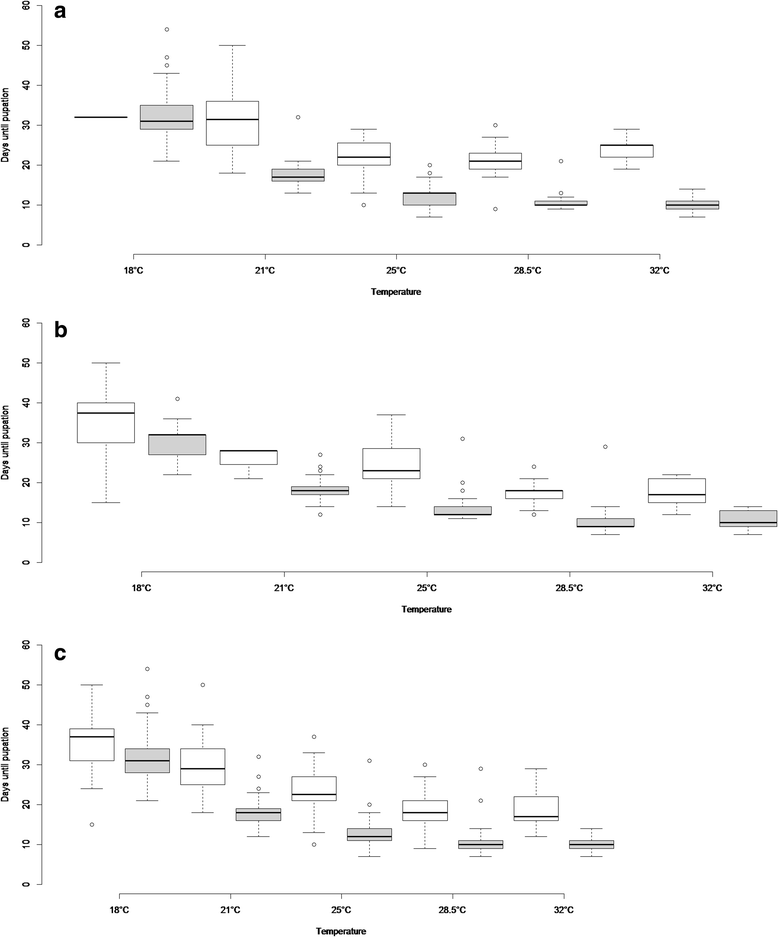Effect of temperature and relative humidity on the development times and survival of Synopsyllus fonquerniei and Xenopsylla cheopis, the flea vectors of plague in Madagascar
- PMID: 26864070
- PMCID: PMC4750303
- DOI: 10.1186/s13071-016-1366-z
Effect of temperature and relative humidity on the development times and survival of Synopsyllus fonquerniei and Xenopsylla cheopis, the flea vectors of plague in Madagascar
Abstract
Background: Plague, a zoonosis caused by Yersinia pestis, is found in Asia, the Americas but mainly in Africa, with the island of Madagascar reporting almost one third of human cases worldwide. In the highlands of Madagascar, plague is transmitted predominantly by two flea species which coexist on the island, but differ in their distribution. The endemic flea, Synopsyllus fonquerniei, dominates flea communities on rats caught outdoors, while the cosmopolitan flea, Xenopsylla cheopis, is found mostly on rats caught in houses. Additionally S. fonquerniei seems restricted to areas above 800 m. Climatic constraints on the development of the two main vectors of plague could explain the differences in their distribution and the seasonal changes in their abundance. Here we present the first study on effects of temperature and relative humidity on the immature stages of both vector species.
Methods: We examined the two species' temperature and humidity requirements under experimental conditions at five different temperatures and two relative humidities. By employing multivariate and survival analysis we established the impact of temperature and relative humidity on development times and survival for both species. Using degree-day analysis we then predicted the average developmental threshold for larvae to reach pupation and for pupae to complete development under each treatment. This analysis was undertaken separately for the two relative humidities and for the two species.
Results: Development times and time to death differed significantly, with the endemic S. fonquerniei taking on average 1.79 times longer to complete development and having a shorter time to death than X. cheopis under adverse conditions with high temperature and low humidity. Temperature had a significant effect on the development times of flea larvae and pupae. While humidity did not affect the development times of either species, it did influence the time of death of S. fonquerniei. Using degree-day analysis we estimated an average developmental threshold of 9 °C for S. fonquerniei, and 12.5 °C for X. cheopis.
Conclusions: While many vector-borne diseases are limited to warm, low-lying regions, plague in Madagascar is unusual in being most prevalent in the cool, highland regions of the country. Our results point towards the possibility that this is because the endemic flea vector, S. fonquerniei, is better adapted to cool temperatures than the exotic flea vector, X. cheopis. Future warming caused by climate change might reduce the area suitable for S. fonquerniei and may thus reduce the incidence of plague in Madagascar.
Figures


References
-
- WHO Human plague: review of regional morbidity and mortality 2004-2009. Wkly Epidemiol Rec. 2010;85:6. - PubMed
-
- Migliani R, Chanteau S, Rahalison L, Ratsitorahina M, Boutin JP, Ratsifasoamanana L, et al. Epidemiological trends for human plague in Madagascar during the second half of the 20th century: a survey of 20,900 notified cases. Trop Med Int Health. 2006;11(8):1228–37. doi: 10.1111/j.1365-3156.2006.01677.x. - DOI - PubMed
Publication types
MeSH terms
Grants and funding
LinkOut - more resources
Full Text Sources
Other Literature Sources

